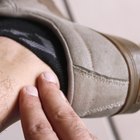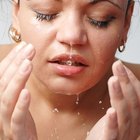
Chris Amaral/Photodisc/Getty Images
As a teenager, you were worried about acne. As an adult, you worry about wrinkles and enlarged pores due to lost skin elasticity. While these skin conditions will naturally occur at some level, knowing how to prevent and treat them can help you to improve your skin’s appearance.
Significance
The skin’s structure comes from elastic fibers that allow the skin to “snap” back when pulled. As you age, the elastic fibers break down, resulting in lost elasticity for the skin. The pull of gravity and fat loss as you age can result in wrinkling. Wrinkles may appear as tiny folds, particularly where your skin moves in your facial expressions -- such as the lines of your face when you smile or the creases in your eyes when you squint, according to “The Doctors Book of Home Remedies.” Enlarged pores are characterized by round openings that can make your skin appear uneven. Because the pores are large, your skin also may appear oily.
Causes
A number of conditions affect the size of your pores, including genetics; if your parents have large pores, you likely will as well. Sun damage that can thicken pore diameter, poor exfoliation and the presence of blackheads all can contribute to enlarged pores.
Wrinkles are predominantly a by-product of aging. Other activities, such as smoking or exposing your skin to excessive amounts of ultraviolet light -- either by the sun or a tanning bed -- also can cause wrinkling.
Prevention
A good skin-care routine can help you to reduce large pores and wrinkles. Cleansing the skin twice daily with a mild cleanser removes excess dirt and oils. A cleanser that contains vitamin C or retinol can help to reduce large pores, according to DocShop.com. Apply a moisturizer that contains a sun protection factor of 15 or higher each day to protect against ultraviolet radiation damage, which leads to wrinkles. Refraining from smoking can prevent the early onset of wrinkles.
Solution
If you experience enlarged pores, apply a skin primer prior to applying makeup. The primer can prevent foundation from soaking into the pores, exaggerating their appearance, according to DocShop.com. Pore-minimizing lotions also are available; they act as a putty to temporarily reduce the appearance of pores. Your physician can prescribe treatments to reduce the appearance of wrinkles. Tretinoin encourages skin-cell growth and exfoliation, according to MedlinePlus. Injectables, such as botulinum toxin, collagen, hyaluronic acid and other ingredients, can be injected to temporarily reduce the appearance of wrinkles.
Warning
While exfoliation is beneficial in treating enlarged pores and wrinkles, refrain from exfoliating excessively, advises Dr. Kunin. Doing so can strip your skin of its natural oils, which can have negative effects on the skin. If your skin turns red or irritated, this can be a sign you have scrubbed too hard. Once to twice per week should be sufficient to exfoliate the skin.
Related Articles

How to Prevent Large Pores

What Do the Horizontal Lines on the ...

How to Get a Pimple to Go Away Fast

How to Shrink Pores With Proactiv

How to Blanch & Peel Hazelnuts

How to Remove a Dilated Pore on the ...

Does Exercise Reduce Wrinkles?

How to Keep Shoes From Rubbing the Heel

Pimples & Potassium Alum

The Wrinkle Rub Out Technique for the ...

Why Do People Get Wrinkles on the Scalp?

Can Age Spots Be Reversed?

Thinning Skin on the Neck

Consequences of Absent & Neglectful ...

Are There Ways to Get Rid of Blocked ...

How to Repair Open Pores

How to Get the Wrinkles Out of Your ...

Can You Tighten Facial Skin With Cold ...

Does Sweating From Exercise Help With ...

How Many Calories Are in Butternut ...
References
- DocShop.com: Large Pores
- "The Doctors of Home Remedies"; William Gottlieb; 1991
- MedlinePlus: Wrinkles
Writer Bio
Rachel Nall began writing in 2003. She is a former managing editor for custom health publications, including physician journals. She has written for The Associated Press and "Jezebel," "Charleston," "Chatter" and "Reach" magazines. Nall is currently pursuing her Bachelor of Science in Nursing at the University of Tennessee.
Photo Credits
Chris Amaral/Photodisc/Getty Images